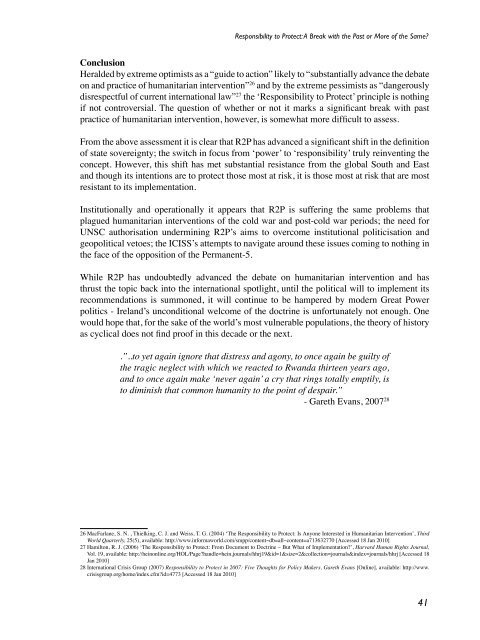Defence Forces Review 2010
Defence Forces Review 2010
Defence Forces Review 2010
You also want an ePaper? Increase the reach of your titles
YUMPU automatically turns print PDFs into web optimized ePapers that Google loves.
Responsibility to Protect: A Break with the Past or More of the Same?ConclusionHeralded by extreme optimists as a “guide to action” likely to “substantially advance the debateon and practice of humanitarian intervention” 26 and by the extreme pessimists as “dangerouslydisrespectful of current international law” 27 the ‘Responsibility to Protect’ principle is nothingif not controversial. The question of whether or not it marks a significant break with pastpractice of humanitarian intervention, however, is somewhat more difficult to assess.From the above assessment it is clear that R2P has advanced a significant shift in the definitionof state sovereignty; the switch in focus from ‘power’ to ‘responsibility’ truly reinventing theconcept. However, this shift has met substantial resistance from the global South and Eastand though its intentions are to protect those most at risk, it is those most at risk that are mostresistant to its implementation.Institutionally and operationally it appears that R2P is suffering the same problems thatplagued humanitarian interventions of the cold war and post-cold war periods; the need forUNSC authorisation undermining R2P’s aims to overcome institutional politicisation andgeopolitical vetoes; the ICISS’s attempts to navigate around these issues coming to nothing inthe face of the opposition of the Permanent-5.While R2P has undoubtedly advanced the debate on humanitarian intervention and hasthrust the topic back into the international spotlight, until the political will to implement itsrecommendations is summoned, it will continue to be hampered by modern Great Powerpolitics - Ireland’s unconditional welcome of the doctrine is unfortunately not enough. Onewould hope that, for the sake of the world’s most vulnerable populations, the theory of historyas cyclical does not find proof in this decade or the next..”..to yet again ignore that distress and agony, to once again be guilty ofthe tragic neglect with which we reacted to Rwanda thirteen years ago,and to once again make ‘never again’ a cry that rings totally emptily, isto diminish that common humanity to the point of despair.”- Gareth Evans, 2007 2826 MacFarlane, S. N. , Thielking, C. J. and Weiss, T. G. (2004) ‘The Responsibility to Protect: Is Anyone Interested in Humanitarian Intervention’, ThirdWorld Quarterly, 25(5), available: http://www.informaworld.com/smpp/content~db=all~content=a713632770 [Accessed 18 Jan <strong>2010</strong>]27 Hamilton, R. J. (2006) ‘The Responsibility to Protect: From Document to Doctrine – But What of Implementation?’, Harvard Human Rights Journal,Vol. 19, available: http://heinonline.org/HOL/Page?handle=hein.journals/hhrj19&id=1&size=2&collection=journals&index=journals/hhrj [Accessed 18Jan <strong>2010</strong>]28 International Crisis Group (2007) Responsibility to Protect in 2007: Five Thoughts for Policy Makers, Gareth Evans [Online], available: http://www.crisisgroup.org/home/index.cfm?id=4773 [Accessed 18 Jan <strong>2010</strong>]41
















